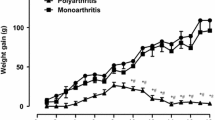Biochemiluminescence, aconitate hydratase activity, and citrate contents were studied in rat serum and muscle in normal animals and in experimental rheumatoid arthritis; the actions of thioctic acid on the background of the development of this pathology were also studied. The development of rheumatoid arthritis in rats was accompanied by increases in marker values and measures of biochemiluminescence, as well as decreases in aconitate hydratase activity, evidently due to the extreme generation of reactive oxygen species associated with the induction of pathology. Suppression of the activity of this enzyme was linked with the accumulation of citrate in the tissues of the experimental rats. Administration of thioctic acid to rats with rheumatoid arthritis was accompanied by changes in values towards the normal, which was evidently linked with the antioxidant action of this compound.



Similar content being viewed by others
References
V. I. Mazurov (ed.), Clinical Rheumatology. Handbook for Doctors [in Russian], Foliant, St. Petersburg (2005).
C. A. Hitchon, N. El-Gabalawy, Arthritis. Res. Ther., 6, 265 – 278 (2004).
R. Stocker and J. F. Jr. Keaney, Physiol. Rev., 84(4), 1381 – 1478 (2004).
J. F. Liang and T. Akaike, Chem. Biol. Interact., 124(1), 53 – 60 (2000).
E. Zacharias, Pharm. Res., No. 48, 585 – 591 (2003).
V. I. Vershinin, I. V. Vlasova, and I. A. Nikiforova, Analytical Chemistry [in Russian], Akademiya, Moscow (2011).
S. A. Lugovskaya, V. V. Dolgov, Laboratory Hematology [in Russian], Triada, Tver’ (2006).
D. N. Kuz’menko and B. I. Laptev, Vopr. Med. Khimii, No. 1, 52 – 57 (1999).
T. I. Rakhmanova, L. V. Matasova, A. V. Semenikhina, et al., Methods for Assessment of Oxidative Status: A Methodological Textbook for Universities [in Russian], Voronezh State University Press, Voronezh (2009).
A. Nissim, R. G. Winyard, V. Corrigall, et al., Arthritis Rheum., 52(12), 3829 – 3838 (2005).
P. G. Winyard, C. J. Moody, and C. Jacob, Biochem. Sci., 30(8), 453 – 461 (2005).
P. R. Gardner, D. M. Nguyen, and C. W. White, Proc. Nat. Acad. Sci. USA, 91(25), 12248 – 12252 (1994).
K. Murakami and M. Yoshino, Mol. Biol. Int., 41(3), 481 – 486 (1997).
Author information
Authors and Affiliations
Corresponding author
Additional information
Translated from Khimiko-Farmatsevticheskii Zhurnal, Vol. 49, No. 9, pp. 8 – 11, September, 2015.
Rights and permissions
About this article
Cite this article
Kryl’skii, E.D., Popova, T.N. & Kirilova, E.M. Effects of Thioctic Acid on the Oxidative Status Tissues in Rheumatoid Arthritis in Rats. Pharm Chem J 49, 578–581 (2015). https://doi.org/10.1007/s11094-015-1332-7
Received:
Published:
Issue Date:
DOI: https://doi.org/10.1007/s11094-015-1332-7



